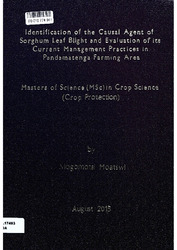Identification of the causal agent of sorghum leaf blight and evaluation of its current management practices in Pandamatenga farming area
Abstract
Turcicum Leaf Blight (TLB) of sorghum incited by Exserohilum turcicum is a major threat to sorghum production globally. This pathogen has been reported to attack both maize and sorghum resulting in yield losses as high as 70% on susceptible cultivars. The leaf blight epidemic in Pandamatenga area is favoured by the abundant inoculum on infested surface residues and soils that tend to water log due to their clay nature. Farmers seem to be applying chemical control measures when the causal agent is not fully known which may lead to waste of money and pollution of the environment.
A study was therefore conducted to identify the pathogen causing the sorghum leaf blight (SLB) in Pandamatenga farms. The objectives of the study were: to identify the pathogen features, assess the incidence of the disease in the area during the 2012/2013 cropping season, assess the survival of the pathogen over a five week period on infested crop residues and in the soil, to assess in-vitro the effectiveness of the fungicides currently being used by farmers in Pandamatenga and assess the response of thirteen different sorghum varieties to the pathogen infection in the green house.
The pathogen causing the leaf blight in Pandamatenga farming area was identified as Exserohilum turcicum. The incidence of the disease in the farms ranged from 2% to 100%, and 100% of farms assessed had the disease in 2012/2013 season. Fungicide in vitro inhibition assays indicated that E. turcicum was sensitive to Propicon 250 EC (propiconazole 250g/l) and Artea (propiconazole 250g/l and cyproconazole 80g/l), but was not affected by Impact (Flutriafol 125g/l). Burial of stubble was found to reduce survival of E turcicum, compared to leaving stubble on the surface.
Sorghum varieties such as Segaolane. Sephala. MR-Taurus and PANNAR 8816 exhibited higher levels of tolerance than NUS 421, NUS 510. NS5655, Tiger and I’ANNAR 8909 to E turcicum infection under greenhouse conditions.
The results for the identification of E turcicum will add to the disease list of sorghum in Botswana and will be useful to farmers when they plan their sorghum crops especially in Pandamatcnga. The results on the reaction of varieties to E. turcicum will be useful to the Department of Agriculture Research (DAR) on evaluation of varietal performance data that might enhance their plant breeding research and the Plant Protection Division (PPD) when they do their disease surveys for compliance data in their endeavour to establish a biosecurity arm of the Ministry of Agriculture. Further research is thus needed to determine how many races of E. turcicum are found in the whole country and also to determine the host range so that an Integrated Disease Management (IDM) can be drawn especially to cater for subsistence farmers.
Collections
- Theses and Dissertations [133]

